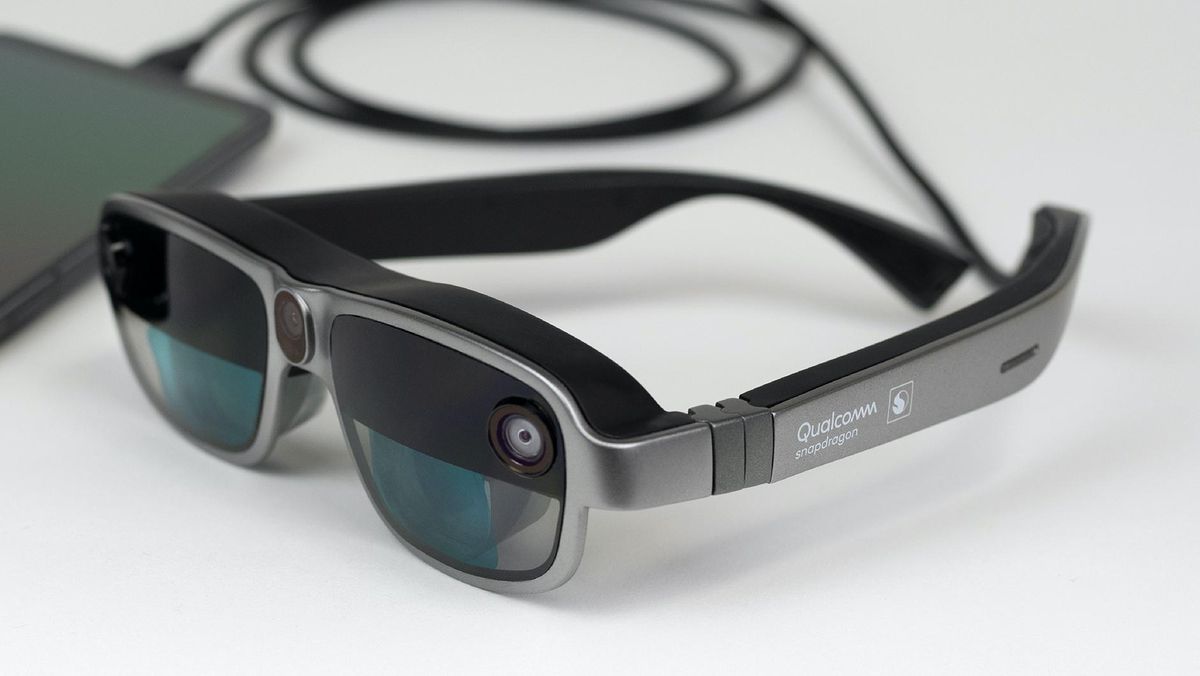[ad_1]
Qualcomm Technologies introduced its new head mounted see-through augmented reality (AR) glasses reference design for “smart viewers,†to reduce the size of the headset while increasing the power. As opposed to smart glasses, the smart viewer offloads some of its processing to a tethered device such as an Android smartphone, Windows PC or processing puck, which reduces power by 30%. The reference design is engineered to reduce commercialization time for Qualcomm hardware partners.Â

Smart Viewer reference design.
Qualcomm provides the Snapdragon XR chips and processing hardware for every XR device except for the Magic Leap One. This includes Microsoft’s see-through AR Hololens, which is focused on enterprise, and Facebook’s Oculus Quest, a fully-occluded stand alone (no wires) VR headset targeting consumers.Â
Fourteen months ago, in December of 2019, Qualcomm announced its new XR2 Snapdragon platform and massively upgraded 865 chipset, optimized for 5G, XR and AI. In addition to across the board upgrades to speed, performance and overall capabilities, the new XR2 platform cme with a reference design featuring seven cameras (or sensor inputs), and a pass through ability that makes the camera your eyes, and enables true MR, as opposed to the see-through method used by the Microsoft HoloLens and Magic Leap One. These designs supported hand tracking, eye-tracking, and magnetic controller tracking. Qualcomm also claims to have a solution for cloud-rendered VR over a 5G network using their latest chipset, which the company calls “boundless XR,†a processing sharing strategy introduced by the company in 2019. Headsets built from thid reference design include Lenovo, which recently unveiled the ThinkRealityTM A3 smart glasses, coming mid-2021. These are tethered to a computer. The ThinkReality A3 provides virtual monitors and 3D visualization among other features.Â

VP and GM of XR, Hugo Swart, presenting in Spatial.io.
At a press event on the XR collaboration and training platform Spatial.io, Hugo Swart, VP and GM of XR for Qualcomm, told us “the Snapdragon XR1 AR smart viewer marks a new chapter for our reference design portfolio and a big step in the evolution of AR viewers. “AR simple viewers showcased viewers as an accessory to a smartphone. Now, AR smart viewers allow us to move some processing to the glass, to expand the possibilities of use cases, applications and immersion – this reference design is the first step in our roadmap to help scale the AR industry.â€Â
The new Qualcomm reference design is optimized for 5G, able to stream high definition, private content. It does plane detection (persistent anchoring of windows), supports 8MB RGB camera with image stabilization for taking still and video images. Dual monochrome cameras on the smart viewer enable six- degrees of freedom (6DoF) head tracking and hand tracking with gesture recognition. A micro-OLED binocular display, that allows frame rates to achieve up to 90Hz and a no-motion-blur feature to deliver a seamless AR experience. The AR smart viewer hardware, developed by Goertek, enables manufacturers to quickly scale and develop their own smart AR devices.

The XR1 reference design allows users to create multiple screens and anchor them to a planar surface … [+]
One the software side, Qualcomm demonstrated a 2D app framework which would allow apps on the device to be brought into multiple virtual screens anchored to a local surface, providing multiscreen virtual monitors that can be anchored within the user’s FOV. This approach is similar to the one used by Nreal, a tethered 5G smartphone coming to the US in a limited release later this year. It’s now available in Korea, Japan, and Europe.
[ad_2]
Source link





